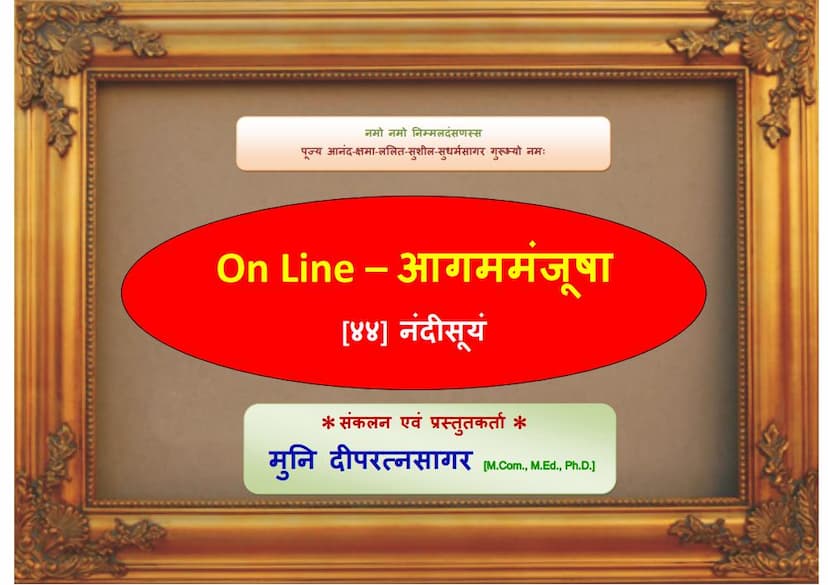Aagam Manjusha 44 Chulikasuttam Mool 01 Nandisuyam
Added to library: September 1, 2025

Summary
This document is an excerpt from "Aagam Manjusha 44 Chulikasuttam Mool 01 Nandisuyam," compiled and presented by Muni Deepratnasagar. The preface highlights that the original "Aagam Manjusha" was edited 70 years prior by Acharya Shri Anand sagarsuriji M.S. This current online version, released in 2012, aims to present the same sacred texts with some useful modifications.
The modifications mentioned include the inclusion of "Niyukti" alongside the original sutras in "Aavashyak Sutra" (Agam-40), "Bhashya" in "Jeetkalp Sutra" (Agam-38), an alternative "Panchkalp" with its Bhashya, and the inclusion of "Pindanuyukti" as an alternative to "Oghnuyukti" (Agam-41). The "Kalp (Barsa) Sutra" is also noted as being included.
The core of the document is the Nandi Sutra itself, presented in Prakrit and translated into Hindi (though the Hindi translation is not fully provided in the excerpt). The Nandi Sutra is a foundational text in Jainism, covering a wide range of philosophical and doctrinal topics.
Here's a breakdown of the key concepts and discussions within the provided pages:
I. Praises and Obeisances: The text begins with salutations to the pure vision (Nirmal Darshan), to the gurus Anand Sagar, Kshama Sagar, Lalit Sagar, Sushil Sagar, and Sudharma Sagar. It also offers prayers to the supreme being, Mahavir, and invokes the auspiciousness of the Nandi Sutra and the teachings of the Jinendra (Tirthankaras).
II. Classification of Knowledge (Gyan): A significant portion of the excerpt delves into the classification of knowledge in Jainism. This includes:
-
Panch Vidh Gyan (Five Types of Knowledge):
- Abhinibodhik Gyan (Sensory and Mental Knowledge): Further categorized into knowledge obtained through the senses (Indriya) and that obtained through the mind (No-Indriya).
- Shrut Gyan (Scriptural Knowledge): Discussed in detail, explaining its relationship with Abhinibodhik Gyan and its various classifications.
- Avadhian Gyan (Clairvoyance): Explained in terms of its types (Bhava-pratyayik and Kshayo-upsamik), its scope (Anugaami, Anaanugaami, Vardhmana, Hiyaman, Pratipaayi, Apratipaayi), and its limitations based on substance, space, time, and state.
- Manahparyav Gyan (Telepathy): Detailed explanation of its origin, scope, and types (Rju-mati and Vipul-mati).
- Keval Gyan (Omniscience): Described as the ultimate knowledge, with its types (Bhava-stha and Siddha), its acquisition, and its characteristics.
-
Paryaksh Gyan (Inferential Knowledge): This section focuses on Shrut Gyan, explaining its various forms and how it is acquired through listening, contemplation, analysis, and retention.
III. Detailed Explanation of Shrut Gyan: The text meticulously breaks down Shrut Gyan into its components:
- Avagrah (Sensory Perception/Reception): Understanding the initial grasp of information.
- Iha (Analysis/Investigation): The process of examining and questioning the perceived information.
- Avaya (Determination/Conclusion): Reaching a conclusion or judgment based on the analysis.
- Dharana (Retention/Memory): Storing the knowledge for future use.
The text further elaborates on the types of "Avagrah," "Iha," "Avaya," and "Dharana," connecting them to the sensory organs and the mind. It also explains the difference between "Vyanjan Avagrah" (grasping the form of letters) and "Arth Avagrah" (grasping the meaning).
IV. Types of Perceptual and Inferential Knowledge: The text distinguishes between perceptual knowledge (Pratyaksh Gyan) and inferential knowledge (Paroksh Gyan), further detailing the nuances within each. It emphasizes that Shrut Gyan is a form of Paroksh Gyan.
V. The Twelve Angas of Jain Agamas: A significant portion of the excerpt provides a comprehensive overview of the twelve Angas (limbs or sections) of the Jain Agamas:
- Acharanga Sutra: Deals with conduct, discipline, and the rules of asceticism.
- Sutrakrutta Sutra: Focuses on the philosophical doctrines, different schools of thought, and refuting erroneous views.
- Sthananga Sutra: Explains the classification and categorization of Jain principles and entities.
- Samvayanga Sutra: Discusses the interrelationship and coordination of Jain doctrines.
- Vyakhyaprajnapti Sutra (or Bhagvati Sutra): A vast compendium of discussions on various philosophical and ethical topics.
- Nyayadharmakatha Sutra: Narrates religious stories and examples to illustrate ethical principles.
- Upaasaka-dashaka Sutra: Describes the conduct and vows of lay disciples (Upaasakas).
- Antakrida-dasha Sutra: Narrates the lives of ascetics who attained liberation.
- Anuttar-Upapatika-dasha Sutra: Describes the lives and destinations of beings in the highest celestial realms.
- Prashna-Vyakaran Sutra: Addresses questions and provides explanations on various topics.
- Vipaka-Shruta Sutra: Details the results ( Vipaka) of karma.
- Drishtivada Sutra: The last and most comprehensive Anga, containing a vast array of philosophical, ethical, and cosmological knowledge, further divided into sub-categories.
The text briefly describes the content and scope of each Anga, highlighting their importance in understanding Jain philosophy and practice.
VI. Classification of "Anunnana" (Analogy/Identification): The latter part of the excerpt delves into the concept of "Anunnana," which refers to the process of analogy, identification, or relating one thing to another. This is explained through various classifications:
- Nama-anunnana (Nominal Identification): Identifying something by its name.
- Sthapana-anunnana (Conventional Identification): Identifying something through symbols or representations.
- Dravya-anunnana (Substantial Identification): Identifying something based on its substance or essence.
- Kshetra-anunnana (Spatial Identification): Identifying something based on its location or space.
- Kala-anunnana (Temporal Identification): Identifying something based on its time.
- Bhava-anunnana (Modal/Qualitative Identification): Identifying something based on its state or quality.
The text further elaborates on the sub-classifications within each type of "Anunnana," connecting them to various philosophical concepts and everyday examples.
VII. Conclusion and Continuity: The excerpt concludes by emphasizing the eternal and unchanging nature of the Jain teachings (Agamas) and their importance throughout time (past, present, and future). It highlights that while the Agamas are immutable, the understanding and practice of their teachings by souls vary across different eras.
In essence, this excerpt from the Nandi Sutra within "Aagam Manjusha" provides a foundational understanding of Jain epistemology, outlining the different types of knowledge and the structure and content of the core Jain scriptures, the twelve Angas. It also introduces the concept of "Anunnana" as a crucial aspect of comprehending and transmitting Jain doctrine.